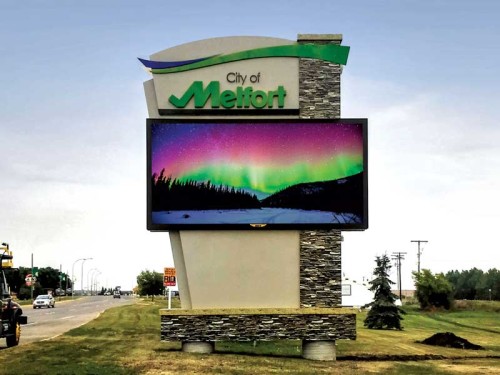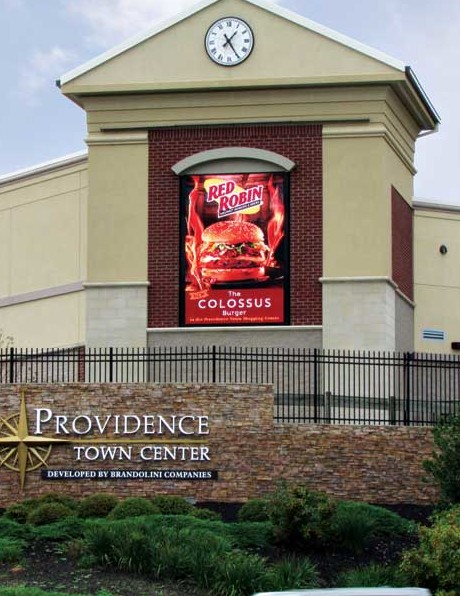EMCs: LED screen sales, permits and installations
by all | 11 April 2016 12:18 pm

Photos courtesy Watchfire Signs
By Ben Barr
Electronic message centres (EMCs) that use light-emitting diodes (LEDs) to convey changeable messages can open tremendous advertising opportunities for businesses and other organizations, along with new sales streams for sign companies. By educating customers, the return on investment (ROI) can become substantial.
EMCs have already become a staple for businesses of all types—and for good reason. Almost 15 years ago, the U.S. Small Business Administration (SBA) issued a report that found a typical increase in sales of 15 to 150 per cent for small businesses that enhance their signage with a light-emitting diode-based (LED-based) EMC. That report made such an impact, many sign companies still quote it today.
Further, according to a survey conducted for the Signage Foundation’s most recent National Signage Research & Education Conference (NSREC), 59 per cent of small business owners enjoy stronger sales after installing an on-premise sign. Hence, the impact of on-premise signage has endured over the years.
Certainly, EMCs now represent a proven advertising medium that has stood the test of time. And as technology has advanced, so too have the capabilities of electronic displays. Today’s LED-based EMCs come with programmable software, for example, which allows the sign’s owner to be put in charge of dynamic content, updating it to meet a variety of business conditions.
Educating the industry and customers
For professionals in the sign industry, continuing to stay educated has been key to keeping up with changes in technology. The industry has diversified over the years with the evolution from basic static signs to early, cumbersome, manual reader boards to dynamic and even interactive screens. This digital segment of the market demands greater knowledge from both sign shops
and the businesses that buy from them in the hopes of boosting their bottom line.
Customers, for their part, should certainly understand the basics about what LED-based technologies are available today, so they will understand how to spot high-quality products, programmable capabilities and self-advertising opportunities. That said, they still require knowledgeable sign industry professionals to help them choose and properly install the right EMC. Too much information can lead to customers concentrating on the wrong elements of their project, such as upfront price to the exclusion of other important cost-saving factors. And no one benefits when a singular focus results in an endless cycle of ‘kicking the tires’ and never making an actual purchasing decision.

The blue colour and triangular shape of this EMC, installed in Winnipeg by Electra Sign, mimic the architecture of the church.
Getting a permit
Of course, before an EMC can be sold and installed, it needs to be supported by the local municipality. Zoning and permit issues have always had an impact on the sign business, but they can be particularly tricky with respect to dynamic displays.
Again, this is an opportunity for educating those involved. Many city and town councils are still learning about the capabilities and features of LED-based EMCs.
With the right sign companies and manufacturers behind them, EMCs can enhance the urban landscape, rather than detract from it, and by generating additional revenue for local businesses, they in turn deliver more taxes to the local government. Beyond these factors in favour of the municipality’s needs, however, it may also be necessary to stand in front of a zoning committee and discuss the technical intricacies of EMCs.
If a sign shop representative does not feel he/she has the necessary expertise for such a discussion, that is where the manufacturer should come in to help as a resource, explaining such points as still image hold time, letter size, dimming and animation. This can be very important in showing how a sign will not only benefit the business using it, but also align with municipal goals. If a city councillor does not realize the brightness of a sign can be adjusted, for example, he/she may well oppose it on the grounds it would become too much of a visual distraction. Sign companies need to work to make sure such decisions are not made without the right information.

As city and town councils learn more about LED-based EMCs, many adopt the technology themselves, as shown with this example in Dauphin, Man.
It is common during zoning hearings to encounter the option to have a sign permitted only through a variance with respect to the local sign bylaw or other ordinance. For the best chance at being granted such a variance, it is important to demonstrate:
1. The variance will not be contrary to the public interest.
2. The spirit of the ordinance will be observed.
3. Substantial justice will be done.
4. The value of the surrounding properties will not diminish.
5. The literal enforcement of the provisions of the ordinance would result in unnecessary hardship for the business.
In many cases, zoning committees will need to be shown how LED EMCs are the latest step in the evolution of signage and, in fact, are often much more visually appealing than outdated, faded static signs. And by providing additional messaging options for local businesses, they can eliminate the need for smaller banners, sandwich boards and temporary signs, thus reducing overall visual clutter in the area.
Using the right content management system (CMS) software, LED-based EMCs can appear professional, clean and modern. Many even become community landmarks by displaying the time, temperature, emergency alerts and other helpful information for passing traffic.
To make these points clear in zoning hearings, it is a good idea to ask the EMC manufacturer to help develop animated renderings of the proposed sign and the content it is intended to display.
Communicating in comfort
As mentioned, CMS software for LED-based EMCs allows businesses to create, schedule and update their own messages. It can also let them diagnose any new problems remotely, from the comfort of their offices.
Overall, CMS packages are becoming easier to use. They are increasingly becoming cloud-based, so their various functions—from content creation to diagnostics—can be accomplished from any Internet-connected device, even a mobile phone.
Of course, this also means the sign needs an Internet connection. The most popular communications technologies for this purpose are radios, fibre optic cables and broadband wireless connectivity.
Radio communications systems offer a wireless point-to-point option for signs. They are especially effective at long ranges of 305 m (1,000 ft) or more. Some models feature frequency agility, which enables a radio to detect any interference and automatically optimize the security of its signals.
Fibre optic cabling can provide a fast, reliable communications infrastructure for digital signage. Indeed, it is usually necessary if a sign is to display live video feeds. The cabling is run through a fibre adapter box, installed within a 38-mm (1.5-in.) conduit. This is often the same conduit used for power lines.
A broadband wireless high-speed Internet connection offers many convenient benefits to sign owners. All information is transmitted and received via cellular modem, providing a secure connection. Not only can businesses troubleshoot and update their signs from other Internet-connected devices using cloud-based software, but they will also find managing content for networks of multiple signs becomes easier.

Fibre optic cabling can provide a fast, reliable communications infrastructure for updating an EMCs content.
Intelligent installations
There are some basic considerations to keep in mind when installing LED-based EMCs as part of an overall sign project. For these purposes, sign companies should work closely with EMC manufacturers.
One of the most important is to understand all of the installation and operation costs associated with the sign. EMCs offer the benefit of continuous advertising because they are capable of operating 24-7 and year-round, but there are expenses involved in such operation that need to be budgeted for before the purchase.
On a similar note, the energy efficiency of large-scale LED arrays has improved significantly over the past five years. So, if an older sign is to be replaced by a new sign of approximately the same size, then the business should find itself drawing substantially less electricity and, thus, paying lower power bills in the future.
Most EMC manufacturers offer information about installation requirements upfront, but in case they don’t, it will be important to ask them the right questions:

Businesses enjoy stronger sales after installing on-premise EMC’s.
1. How is the sign vented?
As with any other electronic device, the power drawn to run an EMC will generate some heat. To ensure continuous operations, the sign needs to be engineered to dissipate this heat to keep its electronic components cool. Ventilation considerations will affect the overall sign design and installation.
2. How should the sign be stored and lifted?
The manufacturer may need to provide additional recommendations with regard to storing and then lifting the sign into place, as part of the overall installation procedures.
3. What are the mounting requirements?
Both to ensure structural longevity in the field and to maintain the conditions for warranty coverage, it is very important for the installer to follow the manufacturer’s guidelines for securely mounting the EMC in place.
4. What is the startup procedure?
The sign company should become familiar with the CMS software to help its customer power up the sign for the first time and begin feeding content to the screen.
When the time comes to install the sign, there are also a few basic safety guidelines to remember. It is essential to install an electrical disconnect for the main power source and to turn off the power before servicing the sign. Proper grounding and electrical installation procedures, as referenced in the manufacturer’s installation manual, should always be followed, along with the applicable local building and electrical codes. Sign equipment should never be serviced under wet conditions. And personal protective equipment (PPE) must always be properly worn when working at heights.
Sign shops that are new to the EMC market should be sure to work with knowledgeable, experienced installers. Their input and help will save a lot of time and trouble, both upfront and down the road, and make for much happier customers.
Ben Barr is a territory manager for Watchfire Signs, which manufactures LED signs that are sold through dealers across North America. For more information, visit www.watchfiresigns.com[1].
- www.watchfiresigns.com: http://www.watchfiresigns.com
Source URL: https://www.signmedia.ca/emcs-led-screen-sales-permits-and-installations/